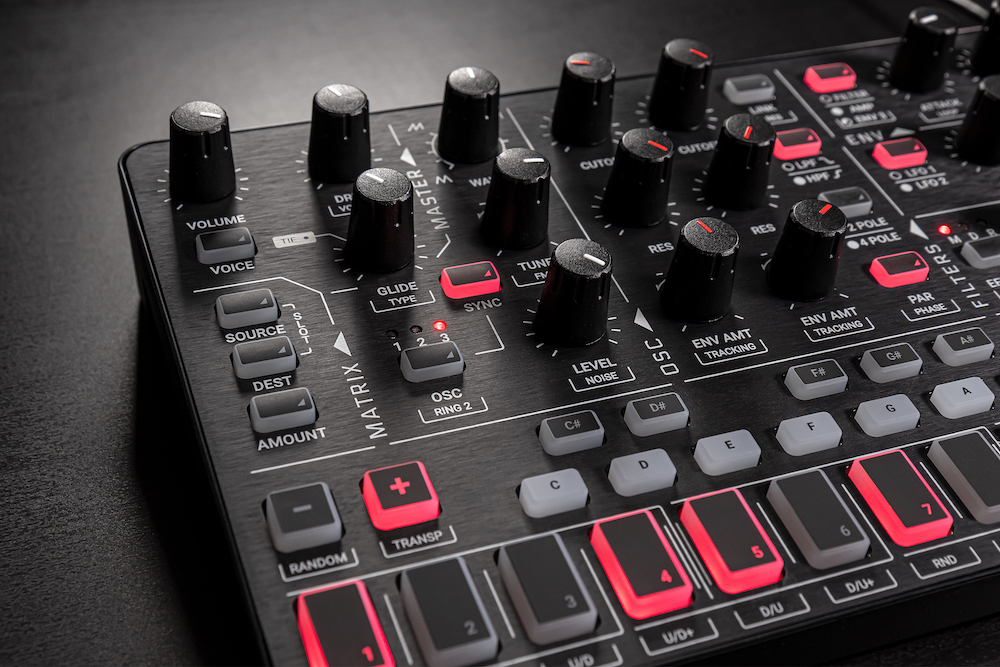The latest version of IK’s analogue Uno Synth series proves to be a serious analogue synth. Greg Scarth finds out what’s new.

Originally launched back in 2018, IK Multimedia’s Uno Synth was a pretty humble-looking instrument which took a few people by surprise with its impressive analogue sound. That original model was followed by the three-voice, paraphonic Uno Synth Pro. Here we have the next step in that evolutionary process, the new IK Multimedia Uno Synth Pro X, a desktop module which expands on the Pro version’s three-oscillator synth engine and prioritises sequencing and hands-on control in order to create a more focussed and capable groovebox than previous Uno Synth models.
The launch version of the Pro X does away with the touch-sensitive capacitive keyboard found on previous Uno Synths, although we wouldn’t be surprised to see a larger keyboard-based version at some point, similar to the Uno Synth Pro 37-Key model. Instead, the Pro X features an octave’s worth of small push-button keys but the focus this time is on much more advanced step sequencing, with a tried-and-test x0x-style row of 16 buttons along the button, representing each step, and buttons on the right allowing you to edit sequences up to 64 steps in length. Elsewhere, it’s immediately apparent that there are lots more physical controls, with dedicated knobs for the oscillator settings, filter section, envelopes, LFO and effects.

In terms of its raw hardware spec, the Uno Synth has grown from that original monophonic model into something way more powerful. The Pro X has plenty in common with the paraphonic Pro model, but it also adds a few nice new features to make things. It’s a three-oscillator design with two filters, all fully analogue. There are two multi-mode filters, one two-pole OTA design and a two/four-pole SSI design, which can be routed in serial or parallel, giving a total of 24 possible modes, including band-pass and notch effects. There are now three envelopes, all of which can loop the attack and decay stages to be used as more complex modulation sources, alongside the LFOs. Effects have also been updated, with Modulation, Delay and Reverb options plus a dedicated knob for the analogue overdrive effect. The sound engine of the Pro was already good, but the Pro X updates add a decent level of extra versatility. The Pro X can do everything from squelchy acid to sizzling paraphonic pads, huge supersaw leads and old-school analogue drum hits.

The Pro X’s sequencer is intuitive and powerful, with the ability to sequence parameter lock-style automation for any parameter for each step and randomise patterns based on a chosen scale. Sequences can be recorded in real time, step time, or converted across from the excellent 10-mode arpeggiator. The new Bassline Mode is an interesting idea, leaning into the Roland TB-303 comparisons of the original Uno Synth. Hitting the Bassline button on the Pro X changes the interaction of the filter and envelopes, while also changing the behaviour of some of the controls in order to mimic the operation of the legendary acid bass synth. That doesn’t mean that it just sounds like a 303, though, because you can still take advantage of the added versatility of the Pro X’s more complex synth engine if you want. A nice option which adds extra character to the synth.

The compact format of the Pro X does mean there are a few compromises, largely in terms of accessing features via menus and shift functions. Instead of a dedicated knob for swing, for instance, you need to hold down Shift, tap the Tie button and then adjust the percentage using the Data knob and readout on the display. Likewise, the way that sequences are stored alongside sounds via the preset menu is a little unusual compared to the typical approach, meaning that you’ll need to store the same sound multiple times if you want to set up variations on a pattern.
With that said, the more knobby control panel of the Pro X is a decent step up in terms of usability from the Pro, evident by the dedicated Glide control, previously edited through a menu but now immediately accessible. The most important parameters can all be accessed quickly enough to make the Pro X a more intuitive, hands-on performance instrument than previous Uno Synth models. If you’re using a DAW, the accompanying editor plugin will make life easier, but the Pro X really stands on its own as a piece of hardware, especially given the major improvement in real-time control over the Pro.

IK isn’t a brand historically known for synths – you might associate the name more closely with mobile interfaces or guitar amp modelling – but the Uno series has grown into something quite serious. The Pro X is a fitting flagship model which holds its own against synths from much more established brands, the likes of the Korg Minilogue and Moog Mother-32. At £468.99, it’s a big step up in price from the original Uno Synth and the Pro model, but it’s a much more powerful synth than its compact proportions and light weight might suggest. To achieve this level of sound while remaining so portable is truly impressive.
Greg Scarth
More info/buy